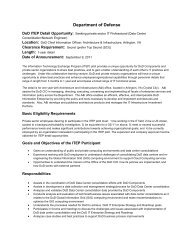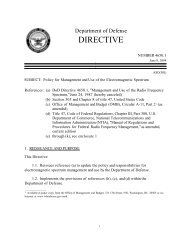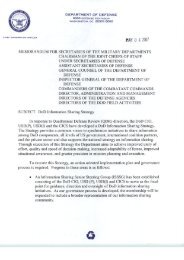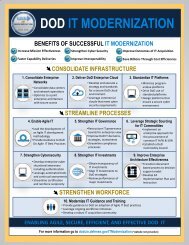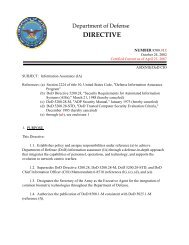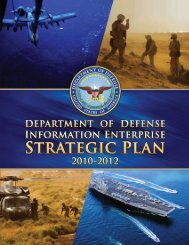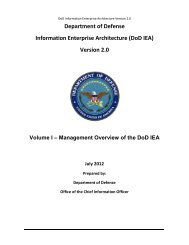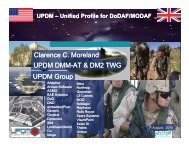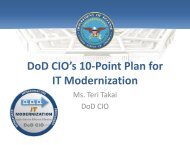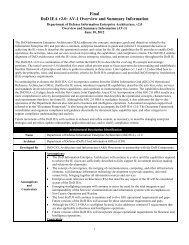DoD Architecture Framework Version 1.5 - Chief Information Officer
DoD Architecture Framework Version 1.5 - Chief Information Officer
DoD Architecture Framework Version 1.5 - Chief Information Officer
You also want an ePaper? Increase the reach of your titles
YUMPU automatically turns print PDFs into web optimized ePapers that Google loves.
Applicable <strong>Architecture</strong> Product Data<br />
Tech<br />
All<br />
Operational View (OV)<br />
Systems and Services View (SV)<br />
Stds<br />
View<br />
View<br />
Uses of <strong>Architecture</strong> Data 1 2 1 2 3 4 5 6 7 1 2 3 4 5 6 7 8 9 10 11 1 2<br />
Analysis & Assessment<br />
Capabilities<br />
- Gaps/Shortfalls • • •<br />
- Mission Effects & Outcomes, Operational<br />
Task Performance<br />
• • • • • • • • • • • <br />
- Trade-Offs • • • • • • • • • • • • • • • • <br />
- Functional Solutions • • • • • • • • • • • • • • • • <br />
Operations<br />
- Process Re-engineering • • • • • •<br />
- Personnel & Organizational Design • • • • • • • • <br />
- Doctrine Development/Validation • • • • • • •<br />
- Operational Planning (CONOPS and TTPs) • • • • • • • • • <br />
Systems/Services<br />
- Communications • • • • • • <br />
- Interoperability and Supportability • • • • • • • • • • • • <br />
- Evolution/Dependencies • • • • • • • • • •<br />
- Materiel Solutions Design & Development • • • • • • • • • • • • • • • <br />
- Facilities Packaging • • • • • • • • • • <br />
- Performance • • • • •<br />
Socialization/Awareness/Discovery<br />
- Training • • • • • • • • • • <br />
- Leadership Development • • • • • • • • <br />
- Metadata (for federation) • <br />
• = Data Highly Applicable<br />
<br />
= Data is Often or Partially Applicable<br />
= Data is Usually Not Applicable<br />
Figure 3-1: <strong>Architecture</strong> Products by Use<br />
Data visualization, the representation of architecture data that relates directly to decision<br />
making architecture requirements, provides value through all tiers of the organization. It allows<br />
one to represent data in a meaningful way for decision makers, while remaining consistent with<br />
the CADM.<br />
3.3 FACILITATING THE USE OF ARCHITECTURE<br />
ASD(NII)/<strong>DoD</strong> CIO wishes to facilitate the use of integrated and federated architectures that<br />
support decision makers in the warfighting, business, intelligence, and enterprise information<br />
environment mission areas. The following sections provide a consistent manner in which to<br />
facilitate the use of architecture at any tier in the organization.<br />
3.3.1 Use the <strong>DoD</strong>AF<br />
<strong>Architecture</strong> descriptions should use common and/or standardized terms and definitions. The<br />
criticality of common language during architecture product creation, analysis, comparison, and<br />
integration cannot be overemphasized. The control of vocabulary, to include the use of a<br />
common language for product names, architecture data elements, and common system data<br />
values, helps to minimize potential misrepresentations and misunderstanding of shared<br />
information, and assists with architecture consistency and validation. The <strong>DoD</strong>AF defines a<br />
standard for architecture data elements, their attributes, and their relationships. The <strong>Framework</strong><br />
requires that every architecture description contain an Integrated Dictionary (AV-2) that defines<br />
terms used in the architecture to ensure semantic understanding across the enterprise.<br />
3-5




